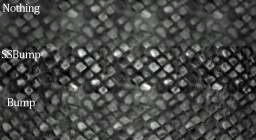$ssbump
$ssbump is a material shader parameter available in all ![]() Source games since
Source games since ![]() Source 2007.
Source 2007.
It is a boolean parameter that flags a $bumpmap texture as being a self-shadowing bump map.
Standard bump maps only darken texels that are facing away from a light source. Self-shadowing bump maps darken both texels facing away and also any texels which are 'behind' them, similar to Ambient Occlusion maps in modern game engines. You can read more about the technology behind it in this paper.
Example
$ssbumpmathfix
The parameter addresses an issue with SSBump textures being too bright. It can be found in the VMT's of ![]() Alien Swarm,
Alien Swarm, ![]() Counter-Strike: Global Offensive,
Counter-Strike: Global Offensive, ![]() Left 4 Dead 2,
Left 4 Dead 2, ![]() Black Mesa and
Black Mesa and ![]() Portal 2. However, the parameter itself does not appear to be functional in some of them.
Portal 2. However, the parameter itself does not appear to be functional in some of them.
|
The parameter addresses the issue of SSBump using non-unit vectors, unlike their regular bump mapping.
More specifically, unlike the
|
$ssbumpmathFix. Multiply your $color parameter by 0.57735 (or, if not present, simply add $color 0.57735).
This works because $color is applied specifically to the lightmap in the shader.Limitations
The shadows cast by the bump map are permanently baked into the texture, meaning that they can only appear in one of three predefined locations. height2ssbump generates shadows for light arriving from the right, top-left, and bottom-left of the texture.
If light arrives from between those directions (such as from the left), the nearest available baked shadows are blended between, producing an acceptable but hardly ideal image.
Additionally, in order to preserve the illusion of height, low areas of a SSBumped material will receive less light even if it arrives head-on. This can look odd if you have too intense (rugged) a SSBump.
SSBumps require bumped lightmaps. As such, they are only supported on brushes and displacements when using vanilla shaders, and implementing them on custom model shaders is non-trivial.
Creation
You need to use height2ssbump, a command line SDK tool. The command is:
height2ssbump <options> <path\to\height map.tga> <float|bumpscale>
The output is <input name>-ssbump.tga, in the same folder as the input file. Bumpscale controls the intensity of the ssbump (i.e., coarseness of the surface); 10.0 is a good starting point.
height2ssbump is currently non-functional in csgo_legacy branch and install the height2ssbump) [todo tested in ?]You can use normal2ssbump, another SDK tool, to generate an SSBump from a normal bump map (as opposed to a height or displacement map) - Unlike height2ssbump you do not need to run through the command line or use any additional parameters; simply drag-and-drop your normal map onto the program or a shortcut.
Options
<path/filename>- The source heightmap (TGA format).
-r <int>- Set the number of 'rays' (default 250). More rays take more time.
-n- Generate a conventional bump map as
<input name>-bump.tga. -d(in all games since )(also in
)(also in  )
)- Generate an ssbump detail texture, used with
$detailblendmode10 and 11.  Confirm:How does this differ from a making regular SSBump? public/bitmap/float_bm.h has a description.
Confirm:How does this differ from a making regular SSBump? public/bitmap/float_bm.h has a description.-A- Generate ambient occlusion in the alpha channel.
-f <int>- Set smoothing filter radius (default 10; 0 disables).
-D- Write out filtered result as
filtered.tga.
An example of a complete command is:
height2ssbump -r 275 "C:\Path\to\example-height.tga" 35
Third Party Tools
Third-party tools capable of generating SSbump maps:
- Substance Designer Utility Node
- Filter Forge 2.0
- Xnormal (In Tools, select 'Height map to normal map', then tick 'Radiosity NM')
- SSbump Generator
| |||||||||||||||||||||||||||||




